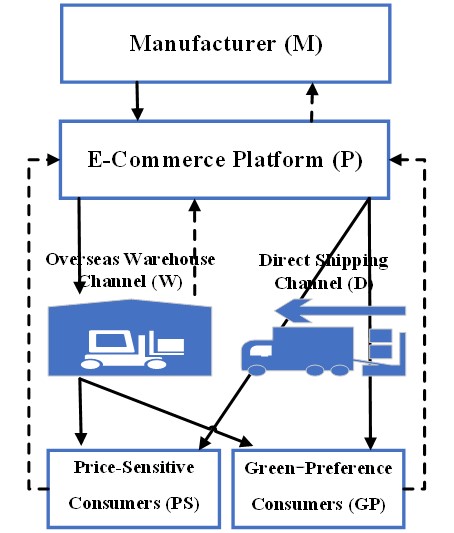Dynamic Collaborative Mechanism of Cross-Border E-Commerce Dual-Channel Supply Chain Under Carbon Quota Constraints
Abstract
In the context of the accelerated global carbon neutrality initiative and the formal enactment of the European Union's Carbon Border Adjustment Mechanism (CBAM), the low-carbon transformation of cross-border e-commerce supply chains has become an inevitable trend. This study examines a dual-channel supply chain comprising manufacturers, e-commerce platforms, logistics service providers—including overseas warehouses and direct shipping—and consumers, all constrained by carbon quotas. Considering heterogeneity in consumer preferences for price sensitivity and environmental sustainability, demand functions are developed to differentiate between price-sensitive and green-preference consumers. A three-stage Stackelberg game model is constructed, with the platform as the leader and manufacturers as followers, to analyze optimal pricing and production strategies under carbon quota constraints. The model is solved via backward induction to obtain equilibrium solutions, which are validated through numerical case analysis. The findings indicate that: (1) Carbon quota constraints significantly influence supply chain pricing strategies and channel selection, compelling firms to internalize carbon costs into their decision-making processes; (2) Enhancing consumers' green preferences effectively incentivizes manufacturers to invest in emission reductions and provides a market foundation for platforms to implement green premium strategies; (3) As the leader, the platform's pricing and channel allocation strategies play a decisive role in the overall profitability and carbon emission performance of the supply chain. These insights offer theoretical contributions and strategic guidance for cross-border e-commerce enterprises aiming to optimize economic and environmental outcomes in alignment with the "dual carbon" objectives.
References
[2] 100EC.CN. (2025, May 28). China cross-border e-commerce market data report. Retrieved August 28, 2025, from https://www.100ec.cn/zt/2024kjds/
[3] Zha, X., Zhang, X., Liu, Y., & Dan, B. (2022). Bonded-warehouse or direct-mail? Logistics mode choice in a cross-border e-commerce supply chain with platform information sharing. Electronic Commerce Research and Applications, 54, 101181. https://doi.org/10.1016/j.elerap.2022.101181
[4] Cheng, W., Wu, Q., Ye, F., & Li, Q. (2022). The impact of government interventions and consumer green preferences on the competition between green and nongreen supply chains. Sustainability, 14(10), 5893. https://doi.org/10.3390/su14105893
[5] Liu, C., Wu, J., & Lakshika Jayetileke, H. (2022). Overseas warehouse deployment for cross-border e-commerce in the context of the belt and road initiative. Sustainability, 14(15), 9642. https://doi.org/10.3390/su14159642
[6] Li, W., Jia, Z., Li, G., & Su, B. (2024). Cross-scale characteristics and emission reduction pathways of trade-embodied carbon flows in the global supply chains. Sustainable Futures, 8, 100290. https://doi.org/10.1016/j.sftr.2024.100290
[7] Li, Y., Zheng, Z., Zhao, M., & Liu, Z. (2024). How does digital trade impact urban carbon emissions efficiency? Evidence from China's cross-border e-commerce pilot zones. Journal of Cleaner Production, 456, 142363. https://doi.org/10.1016/j.jclepro.2024.142363
[8] Zhan, Y., Ren, Y., & Xu, J. (2025). Willingness to pay a premium for eco-label products in China: a mediation model based on quality value. Scientific Reports, 15, 1783. https://doi.org/10.1038/s41598-025-86202-9


This work is licensed under a Creative Commons Attribution 4.0 International License.
Copyright for this article is retained by the author(s), with first publication rights granted to the journal.
This is an open-access article distributed under the terms and conditions of the Creative Commons Attribution license (http://creativecommons.org/licenses/by/4.0/).








1.png)














